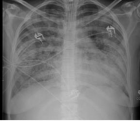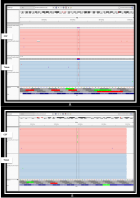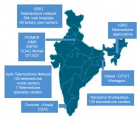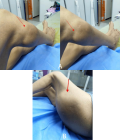Abstract
Case Report
Preservation of Haemostasis with Anti-thrombotic Serotonin Antagonism
Mark IM Noble* and Angela J Drake-Holland
Published: 18 September, 2017 | Volume 1 - Issue 1 | Pages: 019-025
An enquiry into the lack of attention awarded to serotonin antagonism in the treatment of arterial thrombosis revealed that the mode of action of serotonin and its platelet receptor antagonists was an action upon thrombus growth, and not, as with other anti-platelet drugs upon the initiation of thrombosis. This lack of effect could explain why this approach has been considered not to be effective. However under conditions of arterial stenosis in which there is platelet activation by increased shear stress, and during the growth phase of arterial thrombi, serotonin 5HT2A antagonism has been demonstrated to have great potentcy in dispersing thrombotic obstruction to blood flow. This mode of action, the lack of participation of serotonin in haemostasis, and the absence of serotonin in wounds accounts for the proven lack of effect of effect of pure specific 5HT2A antagonists (i.e., not those with other actions) on operative bleeding and skin bleeding times. This lack of effect on haemostasis solves the dosing problem encountered with other anti-thrombotic drugs, with which drug concentration cannot be controlled with single fixed doses, leading to the association between increased anti-thrombotic efficacy and increased bleeding complications. Thus 5HT2A antagonism appears to be the preferred approach, from the point of view of safety and lack of bleeding risk; this consideration applies particularly to thrombosis therapy in the context of traumatic accidents, surgical operations and invasive procedures such as angioplasty.
Read Full Article HTML DOI: 10.29328/journal.jhcr.1001004 Cite this Article Read Full Article PDF
References
- Noble MIM. Thrombosis as a unitary hypothesis of cardiovascular risk. J Cardiovasc Risk. 1995; 2: 177-179. Ref.: https://goo.gl/p8t1XC
- Steinhubi SR, Moliterno DJ. The role of the platelet in the pathogenesis of atherothrombosis. Am J Cardiovasc Drugs. 2005; 5: 399-408. Ref.: https://goo.gl/dpxsc8
- De Meyer SF, Vanhoorelbeke K, Broos K, Salles II, Deckmyn H. Antiplatelet drugs. Br J Haematol. 2008; 142: 515-528. Ref.: https://goo.gl/af7yNg
- Jennings LK. Mechanisms of platelet activation: need for new stratgies to protect against platelet- mediated atherothrombosis. Thromb Haemost. 2009; 102: 248-257. Ref.: https://goo.gl/ogSSLa
- Belcher PR, Drake-Holland AJ, Hynd JW, Noble MIM. Failure of thrombin inhibition to prevent intracoronary thrombosis in the dog. Clin Sci (Lond). 1996; 90: 363-368. Ref.: https://goo.gl/nR7GY7
- Noble MIM, Drake-Holland AJ. The involvement of serotonin in the formation of thrombi at critical coronary artery stenoses in humans. Coronary Artery Disease. 1990; 1: 675-679. Ref.: https://goo.gl/uoVgST
- Noble MIM, Drake-Holland AJ. The possible role of serotonin 5HT2 receptor antagonism in cardioprotection. Neth J Med. 1992; 41: 183-189. Ref.: https://goo.gl/r92Eid
- Noble MIM, Drake-Holland AJ. The role of serotonin 5HT2 receptor antagonism in the control of coronary artery disease. Q J Med. 1994; 87: 11-16. Ref.: https://goo.gl/wbKmLj
- Torr S, Noble MIM, Folts JD. Inhibition of acute platelet thrombosis formation in stenosed canine coronary arteries by the specific serotonin 5HT2 receptor antagonist ritanserin. Cardiovasc Res. 1990; 24: 465-470. Ref.: https://goo.gl/KtDHLQ
- Moerland M, Kemme M, Dijkmans A, Bergougnan L, Burrggraaf J. Modulation of vasoactivity and platelet aggregation by selective 5-HT receptor antagonism in humans. J Cardiovasc Pharmacol. 2011; 58: 575-580. Ref.: https://goo.gl/SWQNk3
- Goto S. Understanding the mechanism and prevention of arterial occlusive thrombus formation by anti-platelet agents. Curr Med Chem cardiovasc Hematol Agents. 2004; 2: 149-156. Ref.: https://goo.gl/Y1DNq4
- Van Nueten JM, Leysen JE, de Clerk F, Vanhoutte PM. Serotonergic receptor subtypes and vascular reactivity. J Cardiovasc Pharmacol. 1984; 6: 564-574. Ref.: https://goo.gl/L7ZWWZ
- Hara H, Osakabe M, Kitajima A, Tamao Y, Kikumoto R. MCI-9042, a new antiplatelet agent is a selective s2-serotonergic receptor antagonist. Thromb Haemost. 1991; 65: 415-420. Ref.: https://goo.gl/d2UEfd
- Golebiewska EM, Poole AW. Platelet secretion: From haemostasis to wound healing and beyond. Blood Rev. 2015; 29: 153-162. Ref.: https://goo.gl/LpvjB1
- Brenner B, Harney JT, Ahmed BA, Jeffus BC, Unal R, et al. Plasma serotonin levels and the platelet transporter. J Neurochem. 2007; 102: 206-215. Ref.: https://goo.gl/UErvuT
- Menys VC, Smith CCT, Lewins P, Farmer RDT, Noble MIM. Platelet 5-hydroxytryptamine is decreased in a preliminary group of depressed patients receiving the 5-hydroxytryptamine re-uptake inhibiting drug fluoxetine. Clin Sci (Lond). 1996; 91: 87-92. Ref.: https://goo.gl/WMAFSu
- Cerrito F, Lazzaro MP, Gaudio E. Arminio P, Aloisi G. 5HT2-receptors and serotonin release: their role in human platelet aggregation. Life Sci. 1993; 53: 209-215. Ref.: https://goo.gl/igVXKw
- De Clerck F. The role of serotonin in thrombogenesis. Clin Physiol Biochem. 1990; 3: 40-49. Ref.: https://goo.gl/F4fTL4
- Belcher, PR, Drake-Holland AJ, Hynd J, Noble MIM. Dispersion of coronary artery thrombi by antagonism of platelet serotonin receptor in the dog. Cardiovasc Res. 1992; 26: 292-296. Ref.: https://goo.gl/no2Kz5
- McAuliffe SJG, Snow HM, Cox B, Smith CTT, Noble MIM. Interaction between the effect of 5-hydroxytryptamine and adrenaline on the growth of platelet thrombi in the coronary artery of the anaesthetised dog. Br J Pharmacol. 1993; 109: 405-410. Ref.: https://goo.gl/QqDdHK
- Belcher PR, Drake-Holland AJ, Noble MIM. Antagonism of the platelet 5HT2 receptor in the presence of thrombolysis. Int J Cardiol. 1994; 43: 11-20. Ref.: https://goo.gl/gZmge7
- Vikenes K, Farstad M, Nordrehaug JE. Serotonin is associated with coronary artery disease and cardiac events. Circulation. 1999; 100: 483-489. Ref.: https://goo.gl/7zZC32
- Millson DS, Jessop CL, Swaisland A, Haworth S, Rushton A, et al. The effect of a selective 5HT2 receptor antagonist (ICI 170,809) on platelet aggregation and puplillary responses in healthy volunteers. Br J Clin Pharmacol. 1992; 33: 281-288. Ref.: https://goo.gl/59y1WZ
- Vandeplassche G, Hermans C, Van Dael L, Wouters l, De Clerke F. Interplay between platelet- derived 5HT and arachidonic acid metabolites limits the thrombolytic efficacy of streptokinase against canine plateler-rich coronary thrombosis. J Cardiovasc Pharmacol. 1993; 21: 56-69. Ref.:
https://goo.gl/Ub8Nsw - Yamada K, Niki H, Nagai H, Nishikawa M, Nakagawa H. Serotonin potentiates high-glucose- induced endothelial injury: the role of serotonin and 5-HT2A recptors in promoting thrombosis in diabetes. J Pharmacol Sci. 2012; 119: 243-250. Ref.: https://goo.gl/sWYXP4
- Ashton JH et al. Serotonin as a mediator of cyclical flow variation in stenosed canine coronary arteries. Circulation. 1986; 73: 572-578. Ref.: https://goo.gl/FSZqUp
- Kirchengast M, Rubsamen K & Lehmann HD. Inhibition by the combined Ca2+ and 5-HT2 receptor antagonist nexopamil (LU 49938) of intracoronary thrombus formation in a canine model of arterial stenosis and intimal damage. J Cardiovasc Pharmacol. 1993; 22: 687-694. Ref.:
https://goo.gl/GS6naX - Hsieh CP, Sakai K, Bruns GC, Dage RC. Effects of MDL 28,133A, a 5-HT2 receptor antagonist, on platelet aggregation and coronary thrombosis in dogs. J Cardiovasc Pharmacol. 1994; 24: 761-772. Ref.: https://goo.gl/otkqNv
- Pawlak D, Pawlak K, Chabielska E, Malyszko J, Takada A, et al. A potent 5HT receptor (5-HT2A) antagonist, DV-7028, delays arterial thombosis development in rats. Thromb Res. 1998; 90: 259-270. Ref.: https://goo.gl/YjmaUJ
- Kihara H, Koganei H, Hirose K, Yamamoto H, Yoshimoto R. Antithrombotic activity of AT-1015, a potent 5-HT2A recptor antagonist, in rat arterial thrombosis model and its effect on bleeding time. Eur J Pharmacology. 2001; 21:157-162. Ref.: https://goo.gl/beQVVZ
- Rashid M, Watanobe M, Nakazawa M, Nakamura T, Hattori K, et al. Assessment of affinity and dissociation of newly synthesized 5-HT2 antagonist, AT-1015: comparison with other 5-HT2 antagonists. Jpn J Pharmaccol. 2001; 87: 189-194. Ref.: https://goo.gl/vXf67z
- Adams JW et al. APD791, a novel 5HT2A receptor antagonist: pharmacological profile, pharmacokinetics, platelet activity and vascular biology. J Pharmacol Exp Ther. 2009; 331: 96-103. Ref.: https://goo.gl/2QSs3x
- Przyklenk K, Frelinger AL3rd, Linden D, Whittaker P, Li Y, et al. Targeted inhibition of the serotonin 5HT2 receptor improves coronary patency in an in vivo model of recurrent thrombosis. J Thromb Haemost. 2010; 8: 331-340. Ref.: https://goo.gl/4VAofo
- Xiong Y, Teegarden BR, Choi JS, Strah-Pleynet S, Decaire M, et al. Discovery and structure- activity relationship of APD791: a highly selective 5HT2A receptor inverse agonist for the treatment of arterial thrombosis. J Med Chem. 2010; 53: 4412-4421. Ref.: https://goo.gl/uDj4Sh
- Sussman N, Ginsberg DL, Bikoff J. Effects of nefazodone on body weight: a pooled analysis of selective serotonin reuptake inhibitor-and imipramine-controlled trials. J Clin Psychiatry. 2001; 62: 256-260. Ref.: https://goo.gl/1dwes2
- Nagatomo T, Rashid M, Abul Muntasir A, Komiyama T. Functions of 5HT2A receptor and its antagonists in the cardiovasclar system. Pharmacol Ther. 2004; 104: 59-81. Ref.: https://goo.gl/gtj7DR
- Sakariassen KS, Hanson SR, Cadroy Y. Methods and models to evaluate shear-dependent and surface reactivity-dependent antithrombotic efficacy. Thromb Res. 2001; 104: 149-174. Ref.: https://goo.gl/rGTRT1
- Valentin JP, View S, Bertolino F, Faure´P, John G. Differential involvement of serotonin 2A/C and thromboxane A2/prostenoid receptors in high- vs. low-shear rate arterial thrombosis in rabbits. J Pharmacol Exp Ther. 1997; 280: 761-769. Ref.: https://goo.gl/mQpcsf
- Stott DJ, Saniabadi AR, Hosie J, Lowe GDO, Ball SG. The effects of the 5HT2 antagonist ritanserin on blood pressure and serotonin-induced platelet aggregation in patients with untreated essential hypertension. Eur J Clin Pharmacol. 1988; 35: 123-129. Ref.: https://goo.gl/mwFrbY
- Vincentelly A, Jude B, Belisle S. Antithrombotic therapy in cardiac surgery. Can J Anaesth. 2006; 53: 89-102. Ref.: https://goo.gl/CxjDgU
- Lin OA, Karim ZA, Vemana HP, Espinosa EV, Khasawneh FT. The antidepressant 5-HT2A receptor antagonists piztifen and cyproheptadine inhibit serotonin-enhanced platelet function. PLoS One. 2014; 23: 87026. Ref.: https://goo.gl/E8J4zh
- Adams JW, Ramirez J, Ortuno D, Shi Y, Thomsen W, et al. Anti-thrombotic and vascular effects of AR246686, a novel 5-HT2A receptor antagonist. Eur J Pharmacol. 2008; 586: 234-243. Ref.: https://goo.gl/h535k1
- Noble MIM, Ford I, Cameron G, Drake-Holland AJ. The novel anti-thrombotic drug with no bleeding excess. J Cardiol Cardiovasc Therap. 2017.
Figures:

Figure 1

Figure 2

Figure 3
Similar Articles
-
Primary Cutaneous Lymphomas and Interferon TreatmentAjda ERSOY GUNES,Melda COMERT OZKAN*,Fahri SAHIN,Guray SAYDAM. Primary Cutaneous Lymphomas and Interferon Treatment. . 2017 doi: 10.29328/journal.jhcr.1001001; 1: 001-010
-
Neutrophil to Lymphocyte Ratio (NLR) in Peripheral Blood: A Novel and Simple Prognostic Predictor of Non-small Cell Lung Cancer (NSCLC)Xiaoli Zhang,Ziyuan Zou,Liyu Fan,Xinjie Xu,Yu Siyuan,Peng Luo*. Neutrophil to Lymphocyte Ratio (NLR) in Peripheral Blood: A Novel and Simple Prognostic Predictor of Non-small Cell Lung Cancer (NSCLC). . 2017 doi: 10.29328/journal.jhcr.1001002; 1: 011-013
-
Cytomegalovirus pneumonia and Cryptogenic organizing pneumonia following pediatric stem cell transplantation for leukemiaZühre Kaya*,Tuba Şişmanlar,Ayşe Tana Aslan,Öznur Konuş Boyunağa,Işıl Fidan Balcı,İdil Yenicesu,Ülker Koçak. Cytomegalovirus pneumonia and Cryptogenic organizing pneumonia following pediatric stem cell transplantation for leukemia. . 2017 doi: 10.29328/journal.jhcr.1001003; 1: 014-018
-
Preservation of Haemostasis with Anti-thrombotic Serotonin AntagonismMark IM Noble*,Angela J Drake-Holland. Preservation of Haemostasis with Anti-thrombotic Serotonin Antagonism. . 2017 doi: 10.29328/journal.jhcr.1001004; 1: 019-025
-
Status of protection against Hepatitis B infection among healthcare workers (HCW) in a tertiary healthcare center in India: results can’t be ignored!Pandey Prashant,Agarwal Nitin*,Das Suryasanta,Dharmendra Kumar. Status of protection against Hepatitis B infection among healthcare workers (HCW) in a tertiary healthcare center in India: results can’t be ignored!. . 2018 doi: 10.29328/journal.jhcr.1001005; 2: 001-005
-
Evaluation of the effects of Leech Salivary Extract (LSE) on Haematological parameters in RatsHausatu Babayi*,Ojo Olufunmilola Praise,Labake Fadipe Ajoke,Israel Kayode Olayemi,Elisha Baba,Oladosun Oluwale Peter. Evaluation of the effects of Leech Salivary Extract (LSE) on Haematological parameters in Rats. . 2018 doi: 10.29328/journal.jhcr.1001006; 2: 006-014
-
Successful management of disseminated Fusarium infection in a patient with acute myeloid leukemiaAlShammasi S,AlNujaidi D,Bakhit K,Algarni A,AlAnazi KA*. Successful management of disseminated Fusarium infection in a patient with acute myeloid leukemia. . 2018 doi: 10.29328/journal.jhcr.1001007; 2: 015-020
-
Reversal of pure red cell aplasia by varicella zoster virus infectionAl-Anazi KA*,Kanfar S,Aldayel A,Abduljalil O,Sayyed AH. Reversal of pure red cell aplasia by varicella zoster virus infection. . 2019 doi: 10.29328/journal.jhcr.1001008; 3: 001-010
-
Varicella zoster virus: The potentially useful virusAl-Anazi KA*,Al-Jasser AM. Varicella zoster virus: The potentially useful virus. . 2019 doi: 10.29328/journal.jhcr.1001009; 3: 011-015
-
The beneficial effects of varicella zoster virusKhalid Ahmed Al-Anazi*,Al-Anazi WK,Al-Jasser AM. The beneficial effects of varicella zoster virus. . 2019 doi: 10.29328/journal.jhcr.1001010; 3: 016-049
Recently Viewed
-
Nasal cytology in patients with previous SARS-CoV-2 infection: occurrence of atypical lymphocytesArturo Armone Caruso*, Anna Miglietta, Giovanni De Rossi, Liliana Nappi, Veronica Viola, Stefano De Rossi, Salvatore Del Prete, Clara Imperatore, Sabato Leo, Daniele Naviglio, Monica Gallo, Daniela Marasco, Lucia Grumetto. Nasal cytology in patients with previous SARS-CoV-2 infection: occurrence of atypical lymphocytes. Adv Treat ENT Disord. 2023: doi: 10.29328/journal.ated.1001014; 7: 001-006
-
Nanoencapsulated Extracts from Leaves of Bauhinia forficata Link: In vitro Antioxidant, Toxicogenetic, and Hypoglycemic Activity Effects in Streptozotocin-induced Diabetic MiceBárbara Verônica Cardoso de Souza, Alessandra Braga Ribeiro*, Rita de Cássia Meneses Oliveira, Julianne Viana Freire Portela, Ana Amélia de Carvalho Melo Cavalcante, Esmeralda Maria Lustosa Barros, Luís Felipe Lima Matos, Tarsia Giabardo Alves, Maria. Nanoencapsulated Extracts from Leaves of Bauhinia forficata Link: In vitro Antioxidant, Toxicogenetic, and Hypoglycemic Activity Effects in Streptozotocin-induced Diabetic Mice. Arch Pharm Pharma Sci. 2024: doi: 10.29328/journal.apps.1001063; 8: 100-115
-
Oral Suspension as Versatile Galenic Formulation in PediatryMauro Luisetto*, Almukthar N, Edbey K, Mashori GR, Fiazza C, Dona’ l, Cabianca L, Latyshev O. Oral Suspension as Versatile Galenic Formulation in Pediatry. Arch Pharm Pharma Sci. 2024: doi: 10.29328/journal.apps.1001062; 8: 091-099
-
Scientific Analysis of Eucharistic Miracles: Importance of a Standardization in EvaluationKelly Kearse*,Frank Ligaj. Scientific Analysis of Eucharistic Miracles: Importance of a Standardization in Evaluation. J Forensic Sci Res. 2024: doi: 10.29328/journal.jfsr.1001068; 8: 078-088
-
The Synergistic Effect of Combined Linagliptin and Metformin Improves Hepatic Function in High-fat Diet/Streptozotocin-induced Diabetic RatsFolasade Omobolanle Ajao*,Ifedolapo Opeyemi Adeyeye,Noheem Olaoluwa Kalejaiye,Sodik Olasunkami Mukaila,Olalekan Samson Agboola,Marcus Olaoye Iyedupe. The Synergistic Effect of Combined Linagliptin and Metformin Improves Hepatic Function in High-fat Diet/Streptozotocin-induced Diabetic Rats. Ann Clin Gastroenterol Hepatol. 2025: doi: 10.29328/journal.acgh.1001050; 9: 004-012
Most Viewed
-
Feasibility study of magnetic sensing for detecting single-neuron action potentialsDenis Tonini,Kai Wu,Renata Saha,Jian-Ping Wang*. Feasibility study of magnetic sensing for detecting single-neuron action potentials. Ann Biomed Sci Eng. 2022 doi: 10.29328/journal.abse.1001018; 6: 019-029
-
Evaluation of In vitro and Ex vivo Models for Studying the Effectiveness of Vaginal Drug Systems in Controlling Microbe Infections: A Systematic ReviewMohammad Hossein Karami*, Majid Abdouss*, Mandana Karami. Evaluation of In vitro and Ex vivo Models for Studying the Effectiveness of Vaginal Drug Systems in Controlling Microbe Infections: A Systematic Review. Clin J Obstet Gynecol. 2023 doi: 10.29328/journal.cjog.1001151; 6: 201-215
-
Prospective Coronavirus Liver Effects: Available KnowledgeAvishek Mandal*. Prospective Coronavirus Liver Effects: Available Knowledge. Ann Clin Gastroenterol Hepatol. 2023 doi: 10.29328/journal.acgh.1001039; 7: 001-010
-
Causal Link between Human Blood Metabolites and Asthma: An Investigation Using Mendelian RandomizationYong-Qing Zhu, Xiao-Yan Meng, Jing-Hua Yang*. Causal Link between Human Blood Metabolites and Asthma: An Investigation Using Mendelian Randomization. Arch Asthma Allergy Immunol. 2023 doi: 10.29328/journal.aaai.1001032; 7: 012-022
-
An algorithm to safely manage oral food challenge in an office-based setting for children with multiple food allergiesNathalie Cottel,Aïcha Dieme,Véronique Orcel,Yannick Chantran,Mélisande Bourgoin-Heck,Jocelyne Just. An algorithm to safely manage oral food challenge in an office-based setting for children with multiple food allergies. Arch Asthma Allergy Immunol. 2021 doi: 10.29328/journal.aaai.1001027; 5: 030-037

HSPI: We're glad you're here. Please click "create a new Query" if you are a new visitor to our website and need further information from us.
If you are already a member of our network and need to keep track of any developments regarding a question you have already submitted, click "take me to my Query."



















































































































































